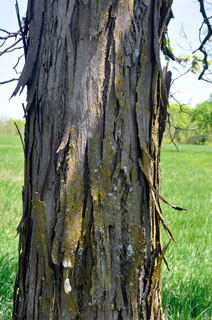SHAGBARK HICKORY
|
 |
| File Size: 137 KB |
|
|
|
Carya ovata (Mill. ) K. Koch
|
| Johnson County, Kansas |
| Height: Trees to 88 feet |
| Family: Juglandaceae - Walnut Family |
| Flowering Period: April, May |
|
| Also Called: | | Shellbark hickory. | | Trunks: | | Erect; bark light gray, fissures shallow, vertical ridges flat-topped, curling and exfoliating in long vertical strips; wood light brown, hard. | | Twigs: | | Reddish brown to grayish brown, rigid, glabrous or hirsute; leaf scars cordate; pith greenish brown, solid; buds brown or reddish brown, ovoid, .2 to .7 inch, apex obtuse, scales glabrate or tomentose. | | Leaves: | | Deciduous, alternate, odd-pinnately compound, 8 to 14 inches; petiole 3.2 to 4.8 inches, glabrous or hirsute; leaflets (3-)5(-7), obovate to ovate or elliptic, not sickle-shaped, 1.6 to 8 inches long, 1.2 to 3.2 inches wide, base unequally wedge-shaped, margins serrate, with tufts of hairs near apices of teeth, apex acuminate, lower surfaces light green, with tufts of hairs along veins and scattered yellow scales, upper surfaces green to yellowish green, glabrous or with scattered simple and tufted hairs and yellow scales; petiolule of terminal leaflet .2 to .6 inch. | | Flowers: | | Inflorescences staminate catkins 3, on wood of the previous or current year, pendent, cylindric, 100-200-flowered, 2.4 to 4.8 inches; peduncles .4 to 1.2 inch, pedicels more or less absent; pistillate spikes terminating new growth, 1-3-flowered; peduncles 0 to .12 inch; pedicels absent.
Flowers unisexual, more or less radially symmetric; staminate: sepals 0 or 4, connate proximally; petals absent; stamens 4-5; pistillate: sepals 0 or 4, connate proximally; petals absent; pistil 1, ovary inferior, 1-locular; styles 2; stigmas yellowish green to green. | | Fruit: | | September-October; nuts enclosed in dehiscent husk, 1-3, globose to nearly globose, 1.2 to 1.6 inch, husk brown to reddish brown, splitting to base, not prominently ridged or winged, smooth; nuts tan, globose to ovoid, slightly compressed, ca. 1 inch long, .7 to 1 inch wide, 4-angled; seed 1. | | Habitat: | | Moist to dry upland forests and woodlands, stream banks, pastures, occasionally floodplain forests. | | Distribution: | | East 1/3 of Kansas | | Origin: | | Native | | Comments: | | Carya ovata is highly variable in leaf morphology and nut shape. Reports of Carya glabra (pignut hickory, broom hickory) in eastern Kansas, a species that occurs in nearby counties in southwestern Missouri, are based on misidentified specimens of C. ovata (McGregor, Brooks, and Hauser 1976). |
|
| Shagbark hickory habit |  | | 137 KB | | Johnson County, Kansas |
| | Shagbark hickory staminate inflorescence |  | | 81 KB | | Johnson County, Kansas |
| | Shagbark hickory leaf |  | | 118 KB | | Brown County, Kansas |
| | Shagbark hickory buds |  | | 30 KB | | Johnson County, Kansas |
| | Shagbark hickory fruit |  | | 54 KB | | Brown County, Kansas |
| | Shagbark hickory bark |  | | 128 KB | | Johnson County,Kansas |
| | Shagbark hickory leaf |  | | 115 KB | | Brown County, Kansas |
| | | |
|
|
|